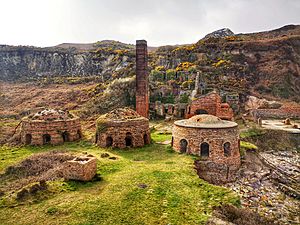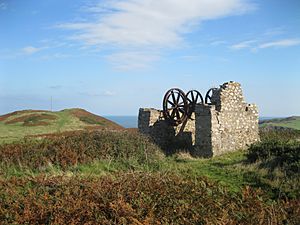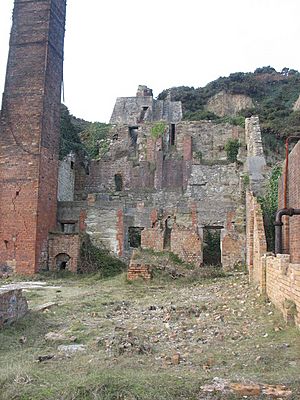Porth Wen Brickworks facts for kids
Quick facts for kids Porth Wen Brickworks |
|
|---|---|

Kilns and chimneys at the brickworks
|
|
| Type | Brickworks |
| Location | Anglesey, Wales |
| OS grid reference | SH 4019 9465 |
| Community | Llanbadrig |
| Principal area | Anglesey |
| Official name: Porth Wen Brickworks | |
| Designated | 27 October 1986 |
| Reference no. | AN109 |
| Lua error in Module:Location_map at line 420: attempt to index field 'wikibase' (a nil value). | |
The Porth Wen Brickworks is an old factory that used to make special bricks. These bricks are called fire bricks. They were made from a hard rock called quartzite. Fire bricks were used to line furnaces (very hot ovens) that made steel.
Even though the factory is not used anymore, many of its buildings and some of its old machines are still there. The sea has caused some damage over time. This site is now a protected historical place called a scheduled monument.
Contents
Where is Porth Wen Brickworks?
The brickworks is in a beautiful spot on the coast of Anglesey, a large island in Wales. It's on the western side of a bay called Porth Wen, which means White Bay in English. The factory is near the village of Llanbadrig.
The brickworks was built here because there was a lot of quartzite rock nearby. This rock was very important for making the special fire bricks. The area around the brickworks is part of the Anglesey Area of Outstanding Natural Beauty. This means it's a special place with beautiful scenery.
What was at the Brickworks?
Porth Wen Brickworks had many parts. It included quarries where rock was dug up, and a special railway (called a tramroad) that went down a slope to the factory. At the factory, there was a crushing house, a moulding shed, drying sheds, and kilns (big ovens).
Other buildings helped the factory work. These included storage areas, an engine house, a boiler house, tall chimneys, a warehouse, and a quay (a dock for ships).
People started making bricks here in the mid-1800s. The buildings you see today were mostly built in the early 1900s. The factory stopped making bricks sometime in the first half of the 20th century. Even though it closed long ago, many of the buildings and machines are still there.
How Rock was Moved and Crushed
The rock for the bricks came from two quarries located north-west of the factory. A special railway, called a tramroad, connected one of the quarries to a winding house. This winding house had a machine that helped move carts up and down a steep slope called an incline.
The winding house had strong stone walls that held a square metal shaft. This shaft had three large wheels. The biggest wheel, about 2 meters (6.5 feet) across, was a brake. The other two wheels, about 1.5 meters (5 feet) across, were used to pull carts up and down the slope.
Near the winding house, there are also the remains of a small storage shed. This shed was likely built later, in the early 1900s, when the factory was improved.
The incline itself had two tracks, but these tracks are gone now. However, you can still see the path where the tracks used to be. Carts would go down the slope using gravity, and the winding house would control their speed.
How Bricks Were Made
The rock from the quarries arrived at the crushing house. Here, large pieces of quartzite were broken into smaller bits using a machine. These smaller pieces then went down chutes to lower levels to be ground even finer, until they became a very fine powder.
This powder was then mixed with lime and water in a large mill. This created a paste. The paste was then shaped and pressed into bricks in the moulding shed. After being shaped, the bricks were moved to drying sheds to dry out. At first, bricks were cut with wires, but later a press was used to shape them.
Once dry, the bricks were fired (baked) in large ovens called kilns. There were three round kilns at Porth Wen. They were made of brick with metal bands around them and had domed roofs.
The brickworks also had a boiler house, which held a large boiler to create steam. This steam powered a small engine in the engine house, which helped run the machinery.
Storing and Shipping Bricks
After the bricks were fired, they were stored in the main factory building. This was an impressive two-story brick building.
From there, the bricks were loaded onto ships. A crane was used to lift the bricks onto ships that were tied up at the loading quay (dock).
History of Porth Wen Brickworks
Porth Wen Brickworks was officially named a "scheduled monument" by Cadw in 1986. This means it's an important historical site that needs to be protected. It is seen as an important example of an industrial brickworks from after the medieval period.



